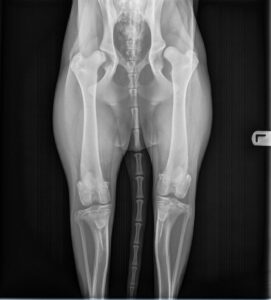
Hip dysplasia is a prevalent orthopedic condition in dogs, with up to 70% of certain breeds experiencing the condition.
Hip dysplasia is a genetic medical disease in which the hip joint doesn’t develop properly. Also, hip dysplasia is a prevalent orthopedic condition in dogs, with up to 70% of certain breeds experiencing the condition. This article informs about hip dysplasia in pets.
What is It?
During growth, the ball and socket that make up the hip joint should grow at equal rates. In hip dysplasia, this equal growth does not happen. This leads to looseness of the joint, resulting in subluxation of the hip. Over time, this will cause osteoarthritis in the affected joint.
Causes and Risk Factors
Since hip dysplasia is a genetic disorder, it is strongly associated with lineage and certain breeds. Even though any dog may be affected, hip dysplasia is primarily seen in larger dogs such as Labrador retrievers, German shepherds, golden retrievers, Saint Bernards, bulldogs, and Old English sheepdogs. Large mixed-breed dogs also have a high risk of developing hip dysplasia. Factors such as environment, diet, growth rate, exercise, hormones, and muscle mass can cause hip dysplasia.
Signs/Symptoms
Weakness and pain in the dog’s hind legs are typical clinical signs. The dog will appear wobbly and be reluctant to get up from a lying or sitting position. Other dogs will limp or be unwilling to climb stairs. However, dogs with mild hip dysplasia on X-rays might not show any signs until they develop arthritis as they age. If you are getting your dog from a breeder and it is a breed known to be prone to the disorder, it is a good idea to inquire about their lineage. Many breeders will have their dog’s hips evaluated prior to breeding to ensure they aren’t passing down the genetic disorder to future litters.
Diagnosis
Clinical signs and palpable joint laxity can indicate hip dysplasia. However, a hip radiograph is the best method for diagnosing this genetic disorder. Depending on the dog’s temperament and the severity of the condition, sedation may be required to get diagnostic quality radiographs.
Treatments/Management
Treatment for hip dysplasia depends on the pet’s clinical signs and severity of discomfort. For mild to moderate cases, medical treatment can be an option. There are numerous practical, non-steroidal anti-inflammatory drugs (NSAIDs), so speak to your vet for options. The medication choice is made individually, and different drugs might be tried before finding the most effective one.
Most dogs with hip dysplasia must receive veterinary-approved joint supplements. Moderate daily exercise and avoiding high-impact activities, like jumping, might assist in keeping the patient mobile and strengthen surrounding support structures. In addition, physical therapy is highly effective at enhancing the quality of life for dogs with hip dysplasia.
In severe cases, your dog may need a total hip replacement. This is a major orthopedic procedure that would need to be performed by a veterinary specialist.
HERE AT MOUNT CARMEL ANIMAL HOSPITAL, WE’LL TREAT YOUR PETS LIKE FAMILY!
Mount Carmel Animal Hospital has been serving the Northern Baltimore/Southern York community for over 30 years and is proud to be an independently operated, small animal practice committed to excellence in veterinary medicine and client service. From grooming to wellness services, along with Canine Life Skills Training Courses, and surgical procedures, we have the expertise that will best serve the needs of you and your pet. Contact us at 410-343-0200 and follow us on Facebook!
